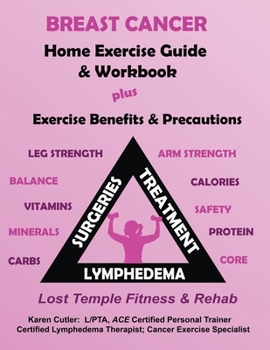Breast Cancer Home Exercise Guide & Workbook: Exercise Benefits & Precautions
It is beneficial for people who are currently undergoing treatment for cancer or survivors to engage in an exercise program. As shown in the second part of this book, exercise can help with endurance, muscle strengthening and flexibility. It is advised that you glance through the chapters Safety First and Components of a Conditioning Program, before starting an exercise program. There are hundreds of pictures for beginner, intermediate and advanced exercise programs, as well as a list of equipment that you can use in the home. This section also includes worksheets and exercise precautions for those at risk for peripheral neuropathy or lymphedema.
Although this book is focused on breast cancer, most of the recommendations can be applied to other cancers, regarding side effects or late effects with treatments, such as radiation and chemotherapy.
The majority of the research is from the National Cancer Institute Please see References.
This book is for:
Those that currently have or are cancer survivors that: Are currently or may have had treatments, such as chemotherapy or radiationAre planning or have had surgeries and/or at risk for lymphedema or peripheral neuropathyThe beginner who has never exercised before or the individual that has mastered the basics but wants to know how to advance to the next level.The personal trainer, physical therapist, or other coaches who would like to know more about precautions with cancer patients or clients.This book is not for or may need modification:
Chronic or acute disorders/injuries that is not being followed by a health care professional. This book can be used in conjunction with a rehab program.If you are over 40 and have never exercised before, it is advised that a physician clears you first.Undiagnosed pain.The person that does not feel they can safely modify their individual program, although can be used in conjunction with rehab or coaches/personal trainers.People going through current treatments, lymphedema or other medical issues that have not been cleared by an MD for an exercise program. Other issues that may be addressed in future volumes: Cancer, Cardiac Disease, Respiratory Disease, Arthritis & Osteoporosis and Diabetes.What is covered in this book?
Cancer / Breast Cancer / LymphedemaBreast Cancer: What is breast cancer?Breast Cancer TypesScreeningPathologyStagingPrognostic MarkersGenesBreast SurgeriesBreast ReconstructionBreast Implants and Tissue ExpandersTissue Flap SurgerySentinel And Axillary Lymph Nodes / DissectionLymph Nodes and LymphedemaRisks After Breast SurgeryHome Exercise Program & Worksheets.Myofascial releaseFlexibility - StretchingCore StabilityStrengthening - Lower extremity (Lying and Seated) and Upper extremityBalance with progression to Standing Strengthening exercisesAgility and EnduranceBenefits and Factors to consider before starting an exercise programVital signs and how to monitor exercise intensityTemperature - Heat and Cold; DehydrationEquipment needed for home exerciseWarm up/cool downDuration, Frequency, Intensity and Primary Movement PatternsAnatomySelf-tests




